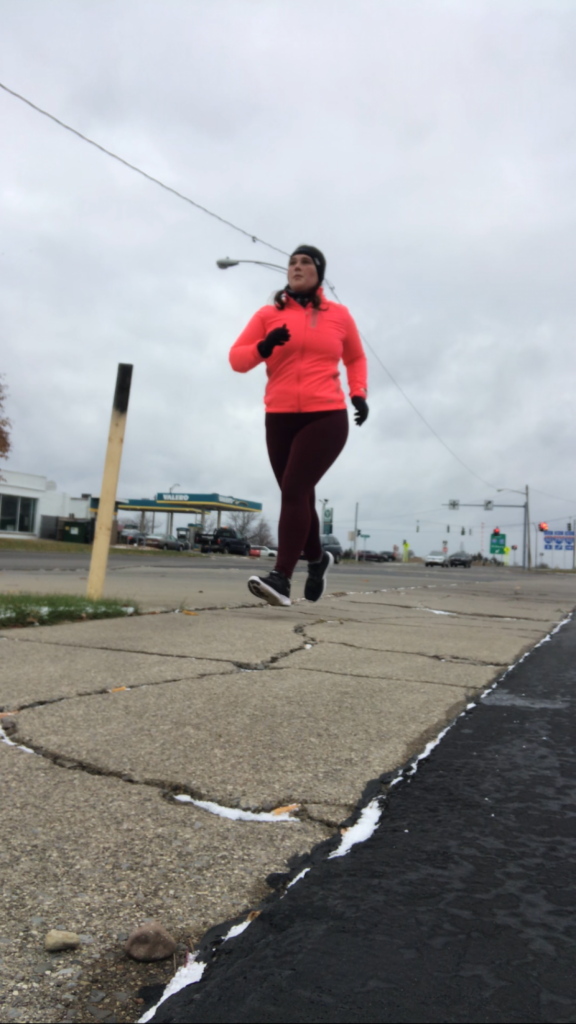It’s February, and for many of us that means winter has settled in and brought with it chilly conditions. I currently live in Buffalo, NY, but I’ve also lived in New England so you might call me an expert in cold weather running. It’s tough to find the motivation and the drive to get your big girl tights on and go for a run when it’s freezing outside, especially when your goal race is in the fall (which just seems so far away right now). To help you survive without having to cut open your Tauntaun, here are my best tips for staying warm when the temperatures drop.
It’s all about the right gear
In Norway, they say: “Det finnes ikke dårlig vær, bare dårlig klær!” (“There’s no bad weather, only bad clothing”).It’s a bit of a cliché, but it’s actually true. Investing in winter gear isn’t just an investment in your coziness, but also an investment in your safety. When it gets really cold, you absolutely must have the right gear to keep you running.
Tight-fitting layers are going to trap heat next to your skin as you begin to warm up during your workout. Make sure you’re wearing moisture-wicking quick-dry fabrics, or merino (a wool that will maintain its warming properties even when it gets wet).Invest in a good pair of fleece-lined running tights (especially if you live somewhere windy – hello, great lakes!). On my head, I alternate between a fleece headband to keep my ears warm but allow heat to escape for days when it’s just cold, and a hat to keep every ounce of heat in for when it’s truly freezing. On arctic days, I’ll wear both.
Layers are your friend
General advice is to dress for weather that’s about ten degrees warmer than it actually is. This is so that you won’t overheat when you start to warm up (yes, you can overheat even during the winter).For me, my test is a little less cerebral: I’ll gear up, step outside, and see if I feel a little bit chilly standing still. Your running gear is designed to keep heat in, so once your body begins to generate heat from your workout you’ll warm up nicely. It can be rough for that first mile, but trust your gear!
One thing you might consider is a short one or two mile loop to start your run. Plan a route that loops you back to your car or house so you can adjust layers if necessary after your warmup. This takes a bit of the anxiety out of preparation because if you find yourself uncomfortable, it will only be for a short time before you can more appropriately layer.
Cut the Wind
If you live somewhere windy, you might find that some layers just don’t keep you warm because the wind goes right through them. Consider a thin outer windbreaker/shell jacket over lighter layers and on your legs those fleece-lined tights have got you covered! Literally!
Warm the Paws
Your extremities (hands and feet) are generally the first things to get cold when you step out into freezing temperatures. This is because your body is trying to keep its core warm and decreases blood flow to extremities in order to protect your vital organs. It’s a natural process, but can be really uncomfortable until you start to warm up from working. To cut the chill, pack a set of hand warmers into your gloves (and, if it’s really cold, stick foot warmers on your socks as well).The heat generated from these small sachets is a nice boost while you’re still acclimating.
Remember to Drink!
Just because you’re not dying of heat doesn’t mean you’re not sweating! You need your hydration and electrolytes just as much in the winter as you do in the summer. Cold air is generally less moist than warm air, which means your body will get zapped by that dry air. Additionally, perspiration evaporates quicker (dry air!) so you may not feel like you’re sweating (trust me, you are!). Last, but certainly not least, because your body is busy working to maintain core temperature, the signals to your brain which indicate dehydration feel very different in the winter (and may not activate at all until it’s too late). Though you may not feel thirsty, your body still needs the fluids. Drink up! If you’re out there for more than an hour, make sure you’re also replacing electrolytes.
Part it Out
If it’s really cold, it may be easier to conceive of your run in pieces. If you have an indoor space available, you can perhaps plan to take some of the run outside but then finish up inside (or vice versa: run inside until you warm up, then move outside to finish things out).This can be easier mentally and decrease the barrier between you and getting out the door. In a lot of ways, winter running is about mind over matter so look to decrease cognitive barriers wherever you can.
Footwear

A good pair of wool-blend socks is the start of any winter running footwear. Remember the same rules for your feet as for the rest of your body: wicking layers that will keep you dry and comfortable. Some companies do make shoes with Gore-tex or similar to repel moisture, but if you have the right socks and you’re careful about foot placement you don’t necessarily need to change your shoes for winter running.
That said, if you plan to run on packed snow or ice for the duration of your run, you should consider investing in some traction cleats for your running shoes. There are a few popular brands of these, but they all amount to a small rubber and metal fitting that goes around the bottom of your running shoes and helps provide traction in unstable footing. A word of caution: traction cleats are designed to work on packed snow or ice only. If your run is on, say, a bike path that’s been plowed but is still under a layer of packed snow they work fantastically. If your run will be on pavement at any time, traction cleats will create unstable, slippery conditions for you. Exercise care when electing to use them!
Warming Up
One of the nicest things about a winter run is getting warm when you come back in. Consider setting up some soup in a crock pot before you leave so you can come home to a warm meal after a nice hot shower. Winter running can be tough but trust me, you’re tougher! You’ll be grateful for the base work you put in now when you’re beating that bridge in October.
Danielle Rosvally is an MCMO four-star diplomat. She’s a runner, triathlete, and strength athlete, and recently became a member of the MCM Runner’s Club! You can find her on Instagram: http://www.instagram.com/thedanibeast
Related Articles
The Crossroads Cup
The Marine Corps Marathon Organization is proud to introduce The Crossroads Cup at the Quantico 12K. New for 2024, Marine Corps Base Quantico units and tenant commands are invited to battle it out on August 24 on the training grounds of the Officer Candidate School (OCS). Participating teams will receive free entry into the Quantico […]
Watch: MCM on the today show
The 39th Commandant of the United States Marine Corps General Smith was featured on the Today show. Watch his story and see how a MCM50K finisher used his CPR training to save Gen Smith’s life.
Sponsor Spotlight: Navy Federal Credit Union
Navy Federal Credit Union serves all members of the armed forces, the DoD, Veterans and their families. We help our members crush their financial goals with low fees, great rates and 24/7 stateside member service. From guidance and support to helpful tools and resources, with Navy Federal, you’ve always got a partner who’s got your […]



